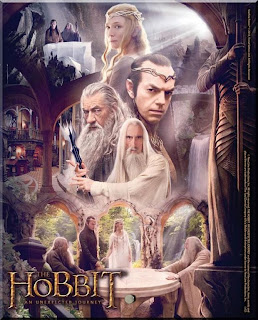For this Principle (Interpretation), I will be looking at the varying visualizations of the Hobbit, comparing the original 1946 illustrations by Tolkien himself; and what material imagery is produced in this present age, for the latest incarnation of the tale for film, directed by Peter Jackson.
Tolkien’s image presented here, and in general with the rest of his illustrated piece’s, showcase the need to give only a vague sense of the overall scene, focusing more strongly on providing the general features and atmosphere. This usually only includes an idea of the environment, e.g: forests, buildings, interiors; leaving the interpretation of the main cast of characters up to the reader to deduce from within their own wild imaginations.
This particular method would only be properly effective, within the form of novelization; that if formulated from an alternative platform present at the time of publication, such as commercialized branding or a full description-heavy illustration, would lack the main essential narrative context needed to ignite the viewers mind, on what they believed things within Tolkien’s world should or should not appear to be, giving them a sense of instant gratification.
The popular illustration and graphic movement at the time would have been that of Art Nouveau, given the stylistic approach to his visualized landscapes, and the use of stark, almost monotone colour palettes, inspired by artists like Aubrey Beardsley and Hugh Lofting, as well as borrowing techniques from artist Jennie Harbour, for the more narrative scene descriptions.
The latest promotional material created for the newest incarnation of “The Hobbit”, directed by Peter Jackson, approaches the depiction of the world’s setting and its inhabitants far differently than what would have been wished for by the author; by creating a permanent, fixed one-sided idea of what the landscapes and characters should appear as to the viewers, via promotional material such as this poster. It takes away the overall aura, left initially by their empty slot in the mind of the person, which would be left to them to fill in a manner that is unique to them. This method of visualizing the world and its subjects for film, on a grand and epic scale suited to the genre of fantasy, and used as a tactic to sell seats at the cinema. This came into prominence around the emergence of the original Star Wars trilogy, back in the late 70’s, which showed that epic scifi/fantasy could succeed at the box office.
An excellent example of an Animator/Illustrator who uses varying mediums to promote and represent themselves, would be Matthieu Bessudo, better known as Mcbess.
His general motto for the direction his career has led him, has always been one that lets him be in control of every single aspect of it; whether that be in illustration, animation or music.
After first rising to fame and popular interest from his involvement in Sigg Jones, a short 3D animated film, his surrealist illustrations and unique characters, contain exquisite amounts of detail. He also makes up one quarter of the band ‘The Dead Pirates‘ for whom he sings, plays guitar, designs merchandise and makes their music video’s.



No comments:
Post a Comment